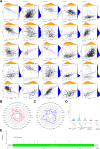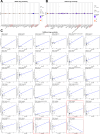Unveiling the unique role of TSPAN7 across tumors: a pan-cancer study incorporating retrospective clinical research and bioinformatic analysis
- PMID: 39175035
- PMCID: PMC11340126
- DOI: 10.1186/s13062-024-00516-8
Unveiling the unique role of TSPAN7 across tumors: a pan-cancer study incorporating retrospective clinical research and bioinformatic analysis
Abstract
Background: TSPAN7 is an important factor in tumor progression. However, the precise function of TSPAN7 and its role in pan-cancer are not clear.
Methods: Based on Xinhua cohort incorporating 370 patients with kidney neoplasm, we conducted differential expression analysis by immunohistochemistry between tumor and normal tissues, and explored correlations of TSPAN7 with patients' survival. Subsequently, we conducted a pan-cancer study, and successively employed differential expression analysis, competing endogenous RNA (ceRNA) analysis, protein-protein interaction (PPI) analysis, correlation analysis of TSPAN7 with clinical characteristics, tumor purity, tumor genomics, tumor immunity, and drug sensitivity. Last but not least, gene set enrichment analysis was applied to identify enriched pathways of TSPAN7.
Results: In Xinhua cohort, TSPAN7 expression was significantly up-regulated (P-value = 0.0019) in tumor tissues of kidney neoplasm patients. High TSPAN7 expression was associated with decreases in overall survival (OS) (P-value = 0.009) and progression-free survival (P-value = 0.009), and it was further revealed as an independent risk factor for OS (P-value = 0.0326, HR = 5.66, 95%CI = 1.155-27.8). In pan-cancer analysis, TSPAN7 expression was down-regulated in most tumors, and it was associated with patients' survival, tumor purity, tumor genomics, tumor immunity, and drug sensitivity. The ceRNA network and PPI network of TSPAN7 were also constructed. Last but not least, the top five enriched pathways of TSPAN7 in various tumors were identified.
Conclusion: TSPAN7 served as a promising biomarker of various tumors, especially kidney neoplasms, and it was closely associated with tumor purity, tumor genomics, tumor immunology, and drug sensitivity in pan-cancer level.
Keywords: Biomarker; Kidney neoplasm; Pan-cancer; TSPAN7; Tumor immunology.
© 2024. The Author(s).
Conflict of interest statement
The authors declare no competing interests.
Figures







Similar articles
-
CD31, EDNRB and TSPAN7 are promising prognostic markers in clear-cell renal cell carcinoma revealed by genome-wide expression analyses of primary tumors and metastases.Int J Cancer. 2012 Sep 1;131(5):E693-704. doi: 10.1002/ijc.27419. Epub 2012 Feb 28. Int J Cancer. 2012. PMID: 22213152
-
The comprehensive potential of AQP1 as a tumor biomarker: evidence from kidney neoplasm cohorts, cell experiments and pan-cancer analysis.Hum Genomics. 2025 Feb 23;19(1):15. doi: 10.1186/s40246-025-00726-9. Hum Genomics. 2025. PMID: 39988693 Free PMC article.
-
Tetraspanin 7 (TSPAN7) expression is upregulated in multiple myeloma patients and inhibits myeloma tumour development in vivo.Exp Cell Res. 2015 Mar 1;332(1):24-38. doi: 10.1016/j.yexcr.2015.01.006. Epub 2015 Jan 28. Exp Cell Res. 2015. PMID: 25637218
-
A Comprehensive Bioinformatic Analysis for Identification of Myeloid-Associated Differentiation Marker as a Potential Negative Prognostic Biomarker in Non-Small-Cell Lung Cancer.Pathol Oncol Res. 2022 Aug 19;28:1610504. doi: 10.3389/pore.2022.1610504. eCollection 2022. Pathol Oncol Res. 2022. PMID: 36061144 Free PMC article.
-
Comprehensive pan-cancer analysis of ZNF337 as a potential diagnostic, immunological, and prognostic biomarker.BMC Cancer. 2024 Aug 9;24(1):987. doi: 10.1186/s12885-024-12703-x. BMC Cancer. 2024. PMID: 39123194 Free PMC article.
Cited by
-
Tetraspanin7 in adipose tissue remodeling and its impact on metabolic health.Mol Metab. 2025 Jul;97:102168. doi: 10.1016/j.molmet.2025.102168. Epub 2025 May 12. Mol Metab. 2025. PMID: 40368161 Free PMC article.
-
Comprehensive pan-cancer analysis indicates UCHL5 as a novel cancer biomarker and promotes cervical cancer progression through the Wnt signaling pathway.Biol Direct. 2024 Dec 19;19(1):139. doi: 10.1186/s13062-024-00588-6. Biol Direct. 2024. PMID: 39702250 Free PMC article.
-
Lymphocyte activation gene 3 served as a potential prognostic and immunological biomarker across various cancer types: a clinical and pan-cancer analysis.Clin Transl Immunology. 2024 Oct 4;13(10):e70009. doi: 10.1002/cti2.70009. eCollection 2024. Clin Transl Immunology. 2024. PMID: 39372371 Free PMC article.
-
Multi-Omics Pan-Cancer Profiling of HSD17B10 Unveils Its Prognostic Potential, Metabolic Regulation, and Immune Microenvironment Interactions.Biology (Basel). 2025 May 19;14(5):567. doi: 10.3390/biology14050567. Biology (Basel). 2025. PMID: 40427756 Free PMC article.
-
Construction and validation of renal cell carcinoma tumor cell differentiation-related prognostic classification (RCC-TCDC): an integrated bioinformatic analysis and clinical study.Ann Med. 2025 Dec;57(1):2490830. doi: 10.1080/07853890.2025.2490830. Epub 2025 Apr 18. Ann Med. 2025. PMID: 40248945 Free PMC article.
References
MeSH terms
Substances
Grants and funding
- 23YF1458400/Shanghai Rising-Star Program (Sailing Special Program)
- 2022-2/Jiaxing Science and Technology Plan Project
- 2023-E-37/2022 medical health key project of Science and Technology Commission of Baoshan District
- BSZK-2023-A06/Baoshan District Health Commission Key Subject Construction Project
- 82173265/National Natural Science Foundation of China
- 82330094/National Natural Science Foundation of China
- 23QC1401400/Shanghai Rising-Star Program
- 2022LJ002/Leading health talents of Shanghai Municipal Health Commission
- 23ZR1441300/Natural Science Foundation of Shanghai Municipality
- 21XHDB06/Hospital Funded Clinical Research, Xinhua Hospital Affiliated to Shanghai Jiao Tong University School of Medicine
LinkOut - more resources
Full Text Sources
Medical
Molecular Biology Databases

